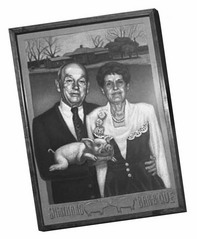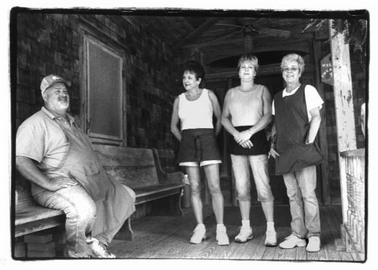“WE’RE LIKE TRAVELING BACK TO AN EARLIER TIME.”

Image 132
“My family was farmers. We raised hogs and row crops,” Bill Sweatman tells me as he pats his brow with a towel draped on his shoulder. He is concentrating on the dozens of ingredients that go into the 80-gallon pot where his legendary hash is concocted.
Bill, a big man with an even bigger voice, can be heard echoing around the cinder-block structure where they smoke and dress the hogs. He took over the hash duty from his father, Elliott, after he passed away in 2001. “I put in my twenty-six years as a long haul trucker. I was ready to come back home, to stay.
“We used to have a big family picnic for granddaddy every year. My dad and uncle would do up a whole hog. Smoke it in a pit. Not much different than what we are serving here today. Word spread, and it seemed like just about every weekend they were doing some function. People were encouraging them to do this full time.”
By the mid 1970s things had gotten so bad for the small family farmer that the Sweatmans did finally give in and heed that advice. They got some land with a farmhouse that looks every day of its 120 years. It is still a work in progress today. Just grab a plate, fill it up, find a place to sit and make yourself right at home. Eat ’til your heart’s content. You can always go back as many times as you want. (Image 133 and Image 134)

Image 133

Image 134: Sweatman’s Bar-B-Que Highway 453 • Holly Hill, SC 29048 • No Phone
A portrait of the founders, Bud and Margie, graces the bead-board walls, but the reigns have long been passed on to their daughters Judy, Patricia and Susan. They manage the kitchen, prepare the sides, stock the buffet, keep the kids in line and needle each other like only sisters can. After all, this is a family gathering.
SOUTH CAROLINA MUSTARD-BASED BARBECUE SAUCE
I got this off the South Carolina Dining website. They say that this one can be traced back to German settlers of the eighteenth century. (Incidentally, I didn’t know that French’s mustard had been around that long.)
In a saucepan, heat all ingredients over medium heat and mix well. Cook until sauce just begins to thicken. Serve cool or warm. The sauce will last a good couple of months in the refrigerator. Makes about 3 cups.
SOUTH CAROLINA HASH
This recipe is from Sadler Taylor, Chief Curator of Folklife Research at the McKissick Museum at the University of South Carolina in Columbia. He said that this is a good basic recipe. He also noted that it is also hard to get an exact break down of the amounts, because it varies so much from batch to batch. If your batch happens to be a little thick (my wooden mixing spoon was able to stand upright), add a little extra tomato sauce or water.
In a 4-quart pot over high heat, mix all ingredients together except the meat; cover and bring to a boil. Reduce heat to a simmer and cover for about 2 hours; stirring occasionally so that it doesn’t burn on the bottom of the pot.
Meanwhile cook the meat according to your preference, just make sure that it is fully cooked. When done, finely chop it up (a food processor works great for this). Stir the meat into the pot for the last 10 minutes of cooking. This is usually made in large batches and also freezes well. Serve over rice, grits or with some white bread.